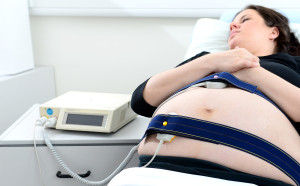Oxford professors’ technology used to assess foetal heartbeats for over 35 years

21st May 2015
Every expectant mother is familiar with the “Sonicaid” – a hand-held monitor used to “hear” the foetal heart beat, monitoring the baby’s health and detecting any early signs of distress in pregnancy. What many don’t realise is that the technology used in some of the “Sonicaid” range of fetal monitors includes the comprehensive heartbeat and fetal movement (cardiotocograph or CTG) analytics developed and refined by University of Oxford Professors Geoffrey Dawes and Christopher Redman.
Oxford University Innovation, the technology transfer company of the University of Oxford, is delighted to announce the renewal of the exclusive licence of this Dawes-Redman CTG Analysis system to Cardiff-based Huntleigh Healthcare.
First licensed to Sonicaid in 1980, the Dawes-Redman CTG Analysis system represents one of the University’s most successful and long-standing clinical advances, and is widely recognised as the reference standard for the assessment of foetal health during pregnancy.
The Dawes-Redman CTG Analysis system has undergone extensive testing and continual refinement over the last 35 years and supported by over 70 peer-reviewed articles, has a proven level of performance accepted by clinicians worldwide.
Traditionally, CTG trace interpretation relied on highly subjective opinion-based processes which were shown to be associated with poor foetal outcomes. To address this, Dawes and Redman (Nuffield Department of Obstetrics and Gynaecology) built up the world’s largest database of CTG traces matched with clinical outcomes (now in excess of 100,000 traces), which they used to create the Dawes-Redman CTG Analysis system.
Analysis of this unique dataset, has allowed the University of Oxford team, led by Professor Redman, to continue to incorporate many new features to the Dawes-Redman CTG Analysis system, for example to avoid misreading of difficult, unusual or rare patterns, which might otherwise lead to adverse clinical events.
When asked about the news, Professor Redman said: ”Huntleigh’s continued support of the data collection process and our research has made an invaluable contribution to the development of our CTG analysis software, and we are delighted that they are reaffirming their commitment to the collaboration. Their reputation and commitment to maintaining the highest standards in clinical care products makes them a natural partner for the Dawes-Redman systems, and we are very much looking forward to continuing to work closely with the Huntleigh team in this next exciting phase.”
Press release sign up
